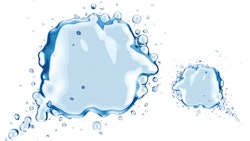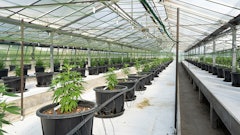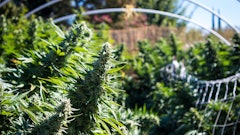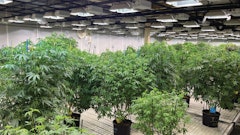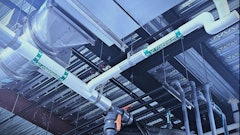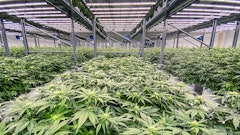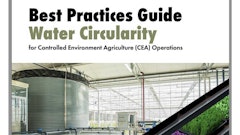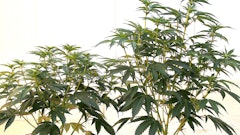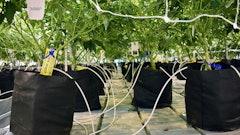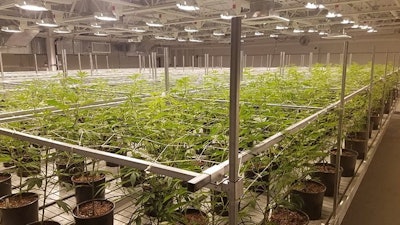
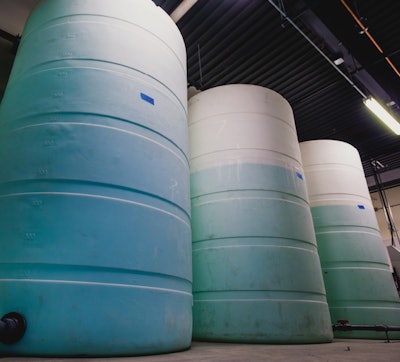
The necessity for cultivation businesses, small and large, to automate their growing procedures to cut production costs becomes increasingly important as the market continues to grow and prices continue to drop. One automation method born from the cultivation of other agricultural products is fertigation.
Fertigation is nothing new to the world of horticulture, but the cannabis industry is giving the process increased exposure.
“Fertigation systems have always been somewhat popular, but they’re definitely trending up due to the cannabis industry,” says Chris Mayer, sales manager of Innovation Growing Equipment in Elgin, Ill. Innovation has been custom building fertigation systems, ebb and flow benches and other growers’ equipment for several years.
Professional growers and fertigation system makers say that automation through a fertigation system is crucial for any cannabis cultivator looking to scale up commercially. While there may be a bit of a learning curve for many growers, Scott Reach, founder of cultivation operation Rare Dankness, says that once cultivators get a grasp of fertigation, “It works like a dream.”
Automating nutrient delivery has some obvious benefits, but several considerations and costs are less apparent, and could help cultivators decide whether or not to implement fertigation, as well as which system is right for a particular operation.
“Nowadays, using hydroponics and fertigation systems, and giving the plants exactly what they need when they need it, is creating a really strong environment for quick transpiration,” says Morris Brink, a business development manager at Argus Control Systems, an automated control systems provider.
Here are strategies and insights to help break down the ins and outs of fertigation and what experts say are best practices for your business.
How Does It Work?
Simply put, fertigation automatically injects fertilizer into your irrigation water. This process removes the need for any hand mixing, which significantly decreases any room for wasted time and resources while keeping processes consistent.
“No longer does your employee have to hand-batch, hand-mix the fertilizers together and then water with a hose. It’s harder to manage that, so through automation, you can get rid of human error and become more consistent in your growing,” says Brink.
The nutrient solution runs from a soluble mixing process in your water tank through your water lines to the plant, like any normal irrigation system. Using a pump, the fertilizer solution feeds the series of plants on a schedule.
Types of Systems
The main consideration when deciding whether to invest in fertigation is envisioning how big your operation will be.
“It’s all about scale,” Brink says. “If you’re a small grower, you can often give your plants a lot of love and have one grower doing everything, and you can do the hand-batch system. But as you scale up, it’s very hard to do that.”
Brink notes that there are “two flavors” of fertigation systems. The first being a system meant for smaller growers, handling one type of fertilizer at a time, that still needs some manual operation. “These have to be hand-adjusted and hand-calibrated, and if you have multiple recipes, you have to hand-adjust.”
As cultivators scale up, the systems become more complex and can handle several nutrient recipes at once. These higher-end machines have software interfaces that can control climate and alarm users when something goes awry, like pH or electrical conductivity (EC) levels being off. These machines will even stop operating if the user doesn’t respond to the alarm.
There are multiple levels of fertigation systems to consider, and prices may vary tremendously. Ryan Miller of Riverview Farms, a cultivation operation in California, says that if your operation is small-scale, it may not be worth that investment.
Anything that is too difficult to manage for a small crew, such as a greenhouse or any crops 3,000 square feet or [more], “you should be considering fertigation,” he says.
Commercial fertigation systems from Dosatron range from $5,000 to $10,000, but that is without any controllers or operating system. A unit with multi-feed injection, operating system and controllers that Argus offers might cost in the $40,000 to $45,000 range, according to Brink. He recommends finding a company that has a history in horticulture when looking for the right fertigation system.
“Look at what the commercial greenhouse guys are doing … and we can learn so much. There is no reason to reinvent the wheel and create a new fertigation unit,” Brink says.
Maintenance
Aside from initial setup, the most important task is the small, daily maintenance required to keep your fertigation system running smoothly. As much as the system reduces physical labor, a human touch remains crucial to any growing operation. Miller advises examining your lines every day to make sure the plants are getting an even dose, and to check for leaks in your lines. He cautions that a single leak anywhere could impact your entire crop. “If you were fertigating, [and] walking away and not looking, you could be dumping out of that line and having uneven pressure across your whole system, and have no idea how much that plant got fertilized or how much that section of the greenhouse did,” Miller says.
Both Reach and Miller agree that keeping your tanks and lines clean after each use is an easy maintenance step to forget. Without proper cleaning of the tanks, sedimentation can build up and pH levels can be affected, possibly unbalancing the nutrients being fed to your plants.
“Keep them clean, and they run really nice,” Reach says. “The second you let something clog up, or you let one of the meters get out of whack or range, you’ll definitely get some alarms.”
Simply cleaning with water and hydrogen peroxide is good enough to clean the big tanks, although other organic methods work as well. So long as the tank and lines are flushed with water after, it should keep the system from affecting the mixture each time, according to Miller.
Costs to Consider
When purchasing a fertigation system, buyers should be aware of other costs that can quickly soar in their operations.
“Everything goes up exponentially, like the amount of PVC you’re going to need,” Reach says. “All of a sudden, you have a few hundred of these and a few thousand of those, you can be $10,000 or $15,000 over your budget or more.”
Rest assured, Miller says, the benefits gained from taking the time to get fertigation right will quickly show with reduced labor costs and efficient use of water and nutrients. “[Fertigation systems] will pay themselves off in one harvest. No question,” Miller says.
While the fertigation system itself is designed to automate much of the grower process, certain hardware accessories can be helpful to getting the most out of your unit, like a potting machine and a mixing machine.
Computer software or a centralized operating system, which monitors all automated aspects of your grow operation, may be the most useful. Whether you use a standalone computer system or a centralized operating system that connects to your computer, the sheer amount of data you receive gives you instant analysis of what’s working and what’s not, over time. It saves you from having to manually measure stock tanks, raw fertilizer, light temperature, pH, EC, among other things that keep your plants at optimum health.

“It monitors everything down to the minute that you can go back and look at weeks’ worth or months’ worth of temperatures and irrigation cycles mixed in with humidity spikes,” says Reach, who uses an operating system (OS) from Priva, which makes an OS for irrigation and climate control. “You can see where you are creating these humidity spikes in your room a lot of times and try to figure out how to head those off before they happen.”
Another accessory to consider is an ebb and flow bench, a hydroponic system that utilizes and drains the irrigation water that is either recirculated or discharged, greatly reducing labor. If you’re using a fertigation system and an ebb and flow bench, “labor-wise, you can save up to 60 to 90 percent, if you do your whole facility with those two products,” says Mayer.
Reach further emphasizes the importance of recirculating the water you use.“It’ll definitely increase your costs a little bit,” he says. “But the amount of money you save in water usage [and] the amount of money you save in nutrients can definitely make up for the initial investment.”
The diminished need for labor has led many to fear that automation will remove the human element from cannabis production, according to Brink.
“Don’t be afraid of automation,” Brink says. “And don’t lose touch of the human side. Make sure that you’re going out there and seeing all your plants, and checking it out and making adjustments if you need to.”
Mayer says he has not encountered apprehension toward adjusting to running a grow with a fertigation system. “Once they’ve tried it, they said they wish they got it 20 years ago,” he says.
Brink and Reach both advise new fertigation adopters to start small and carefully. “Don’t go from tried and true to doing nutrient salts on the first go. Try things first on smaller scales,” Brink says.
For cultivators undergoing a steep learning curve implementing the fertigation system, many fertigation companies offer onsite or on-the-phone assistance.
Reach, who has a background in mechanics, learned his system by taking it apart and putting it back together. But he expressed gratitude for having assistance from his system’s representative.
“Anytime I have an environmental question, whether it’s with a fan coil or a zone pump or HVAC pumps … I can get him on the line, and he can dial in and look at what’s going on in our system,” Reach says.
When cultivators want to scale up and automate, fertigation is a tried-and-true process to adopt that offers a higher rate of consistency.










